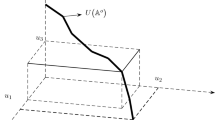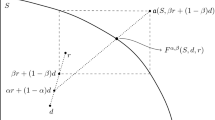Abstract
This essay aims at constructing an abstract mathematical system which, when interpreted, serves to portray group-choices among alternatives that need not be quantifiable. The system in question is a complete distributive lattice, on which a class of non-negative real-valued homomorphisms is defined. Reinforced with appropriate axioms, this class becomes a convex distributive lattice. If this lattice is equipped with a suitable measure, and if the mentioned class of homomorphisms is equipped with a metric, then the class and its convex sets are seen to possess certain characteristic properties. The main result (Theorem 6) follows from a combination of these results and a famous result due to Choquet.
The mathematical scheme is then interpreted in the subject-language of ‘choice among alternatives’. It is shown, by means of an example, that the system furnishes all the ingredients for describing multi-group choices. Whether or not the same ingredients are also adequate for a behavioural theory of multi-group choices is an issue that will not be gone into. However, the example effectively illustrates how a process of bargaining can be described with the aid of the mathematical scheme.
In the second example, a class of bargaining situations is modelled in the symbolism of linear programming with several objective functions combined with unknown ‘weights’; the ‘cost’ vectors in such formulations are identified with homomorphisms, and the main theorem of this essay is applied.
Similar content being viewed by others
References
Glivenko, V.: 1937, ‘Contribution a l'étude des Systemes de Choses Normées’, Amer. J. Math. 59, 941–956.
Kelly, J. L.: 1955, General Topology, D. van Nostrand, New York.
Rudin, W.: 1964, Principles of Mathematical Analysis, McGraw-Hill, New York.
Phelps, R. W.: 1966, Lectures on Choquet's Theorem, van Nostrand Mathematical Studies No. 7, D. van Nostrand, New York.
(a)Podtebarac, M. L. and S. S. Sengupta: 1971, ‘Parametric Linear Programming: Some Extensions’, INFOR 9, 305–319.
Sengupta, S. S., M. L. Podrebarac, and T. D. H. Fernando: 1973, ‘Probabilities of Optima in Multi-Objective Linear Programmes’, in J. L. Cochrane and M. Zeleny (eds.), Multicriteria Decision Making, University of South Carolina Press, Columbia.
Szász, G.: 1963, Introduction to Lattice Theory, Academic Press, New York.
Donnellan, T.: 1968, Lattice Theory, Pergamon Press, Oxford.
Author information
Authors and Affiliations
Rights and permissions
About this article
Cite this article
Sengupta, S.S. Lattices, bargaining and group decisions. Theor Decis 16, 111–134 (1984). https://doi.org/10.1007/BF00125874
Issue Date:
DOI: https://doi.org/10.1007/BF00125874




